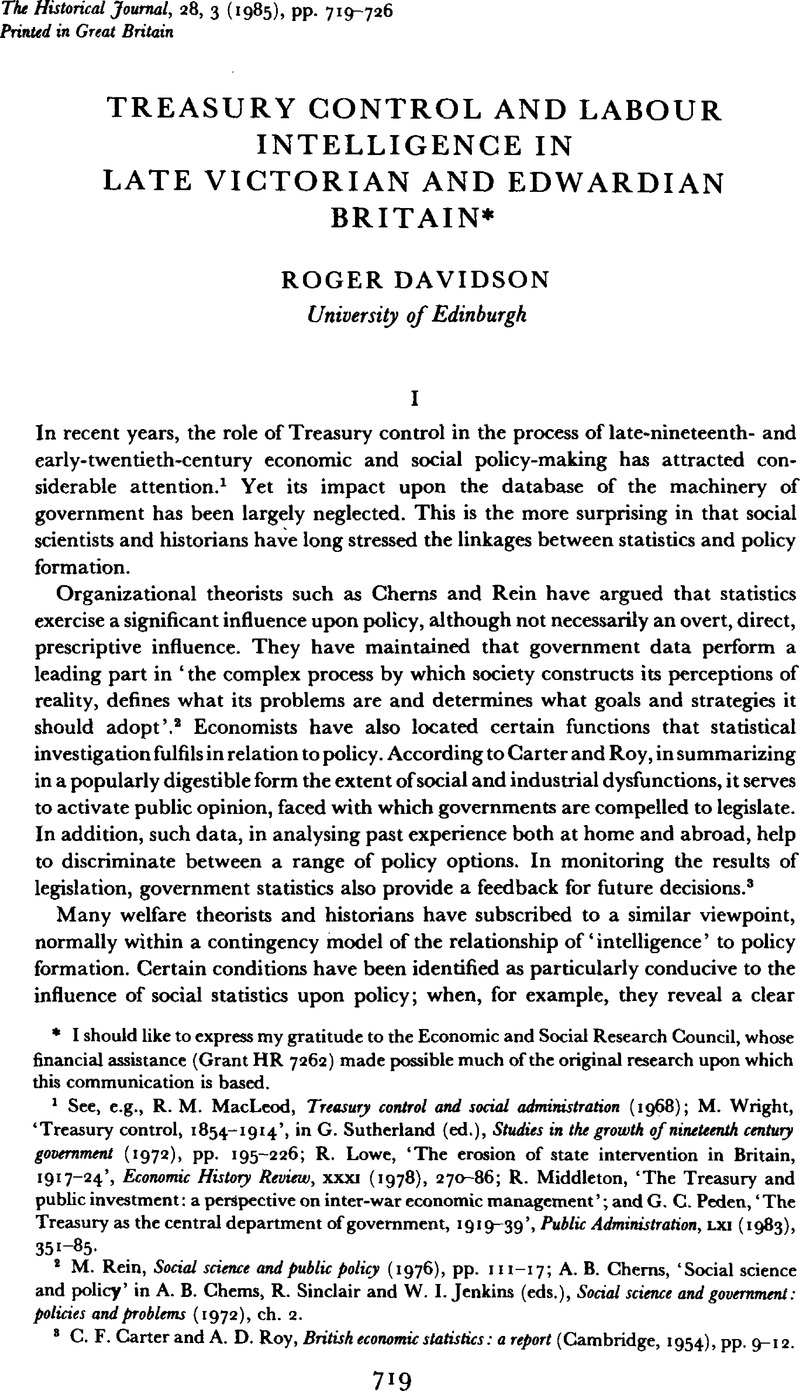Article contents
Treasury Control and Labour Intelligence in Late Victorian and Edwardian Britain*
Published online by Cambridge University Press: 11 February 2009
Abstract

- Type
- Communications
- Information
- Copyright
- Copyright © Cambridge University Press 1985
References
1 See, e.g., MacLeod, R. M., Treasury control and social administration (1968)Google Scholar; Wright, M., ‘Treasury control, 1854–1914’, in Sutherland, G. (ed.), Studies in the growth of nineteenth century government (1972), pp. 195–226Google Scholar; Lowe, R., “The erosion of state intervention in Britain, 1917–24”, Economic History Review, XXXI (1978), 270–86CrossRefGoogle Scholar; R. Middleton, ‘The Treasury and public investment: a perspective on inter-war economic management’; and Peden, G. C., ‘The Treasury as the central department of government, 1919–39’, Public Administration, LXI (1983), 351–85Google Scholar.
2 Rein, M., Social science and public policy (1976), pp. 111–17Google Scholar; Cherns, A. B., ‘Social science and policy’ in Chems, A. B., Sinclair, R. and Jenkins, W. I. (eds.), Social science and government: policies and problems (1972), ch. 2Google Scholar.
3 Carter, C. F. and Roy, A. D., British economic statistics: a report (Cambridge, 1954), pp. 9–12Google Scholar.
4 See, e.g., Hall, P., Land, H. et al. , Change, choice and conflict in social policy (1975), pp. 501–6Google Scholar.
5 MacDonagh, O. O. G. M., ‘The nineteenth century revolution in government: a reappraisal’, Historical Journal, 1 (1958), 52–67CrossRefGoogle Scholar.
6 P.R.O., HO 45/11787/B32589/2, Treasury minute, 21 April 1882.
7 P.R.O., T 1/11170/25785, memo. by G. Barstow, 5 Nov. 1907.
8 P.R.O., T 1/11791/13516, Treasury minute, 24 March 1915.
9 Journal of the Royal Statistical Society, LXX (1907), 557Google Scholar.
10 Roseveare, H., The Treasury (1969), ch. 6–7Google Scholar; MacLeod, R. M., Treasury control and social administration (1968), passimGoogle Scholar.
11 Sources: P.R.O., T 1, Treasury Board papers; T 9, Treasury out-letters; BT 13, Board of Trade Establishment Department, correspondence and papers; Department of Employment Library, series 9070, Board of Trade staff lists; P.P., Annual civil service estimates and Appropriation accounts.
12 P.R.O., T 1/8369 B/18036, minute by Sir Reginald Welby, 3 March 1887.
13 P.R.O., BT 14/IND 20472, Treasury to Board of Trade, 28 April and 11 June 1886.
14 P.R.O., T1/8243 B/11800, minute by Welby, 14 April 1886.
15 Schloss, D. F., ‘The reorganisation of our Labour Department’, Journal of the Royal Statistical Society, LVI (1893), 45Google Scholar.
16 Ibid. p. 59. For details of the appropriation of American State Bureaus, see P.P. 1894 (C.7421) XXXV, 228.
17 P.R.O., T 1/8743 A/10410, memo. by Mowatt, 30 Dec. 1892.
18 See, e.g., P.R.O., T 1/8857 C/13679.
19 P.R.O., T 1/9891 A/18946.
20 See, e.g., P.R.O., T 1/9109B/18813.
21 P.R.O., T 1/9636A/1448, minute by F. Mowatt, 3 Jan. 1901; LAB2/1555/L 1099/1903, minute by H. Llewellyn Smith, 18 July 1903.
22 P.R.O., LAB 41/151, minute by F. H. MacLeod, 6 Dec. 1906.
23 P.R.O., T 1/18410/10518A, Treasury to Board of Trade, 5 Sept. 1905.
24 P.R.O., T 1/10241B/2068; T 1/10524A/19025.
25 P.R.O., T 1/10562/22706; LAB 41/213, G. H. Wood to F. H. MacLeod, 25 May 1909.
26 P.R.O., T 1/10054B/21516, Llewellyn Smith to Mowatt, 13 June 1903. For the inability of the Board of Trade to cope with the statistical demands of the Tariff Reform controversy, see also Walter Layton papers, unpublished autobiography, pp. 13a, 15.
27 P.R.O., T 1/10241B/2068, minute by T. L. Heath, 9 Feb. 1905.
28 P.R.O., T 1/31/pp. 583–4; T 1/10054B/21516; T 1/10659A/13618.
29 Lloyd George papers, B/1/1/10, Llewellyn Smith to Lloyd George, 24 Dec. 1907; S.C. on post office servants (wages and conditions of employment), mins. of ev., PP 1906 (308) XII. pt.1, Q.7237; 1913; (268) XII, Q.27274.
30 Hansard, 4th Series, 177, Col. 164, 27 June 1907. Lloyd George: ‘The Statistical Department of the Board of Trade was the Intelligence Department of the commerce and industry of the country … and should be as efficient as the Intelligence Department in War’; P.R.O., T 1/10562/22706, minute by Sir George Murray, 31 Dec. 1906.
31 P.R.O., BT 13/134, Churchill to Llewellyn Smith, 8 April 1909; Passfield papers, Beatrice Webb diary, 24 March 1908.
32 P.R.O., LAB 41/213, G. H. Wood to F. H. MacLeod, 11 June 1909.
33 P.R.O., T 1/11700/26594, minute by R. G. Hawtrey, 3 March 1909; T 9/41, Treasury to Board of Trade, 22 Feb. 1912.
34 P.R.O., LAB 41/213, G. H. Wood to F. H. MacLeod, 11 April 1912.
35 P.R.O., BT 13/134, memo. on ‘The organisation of the commercial, labour, and statistical department’ by Stanley, G. J., 30 03 1909Google Scholar.
36 P.R.O., T 1/11646/13667, Llewellyn Smith to Sydney Buxton, 24 March 1913. Equally symptomatic of the Treasury's lack of appreciation of the data needs of welfare administration was its refusal to sanction the appointment of a permanent actuarial adviser to the Board to assess the viability of existing and projected schemes of insurance. See P.K.O., BT 13/E37900; T 1/11481/22621.
37 Wright, , ‘Treasury Control 1854–1914’, p. 222Google Scholar.
- 3
- Cited by




